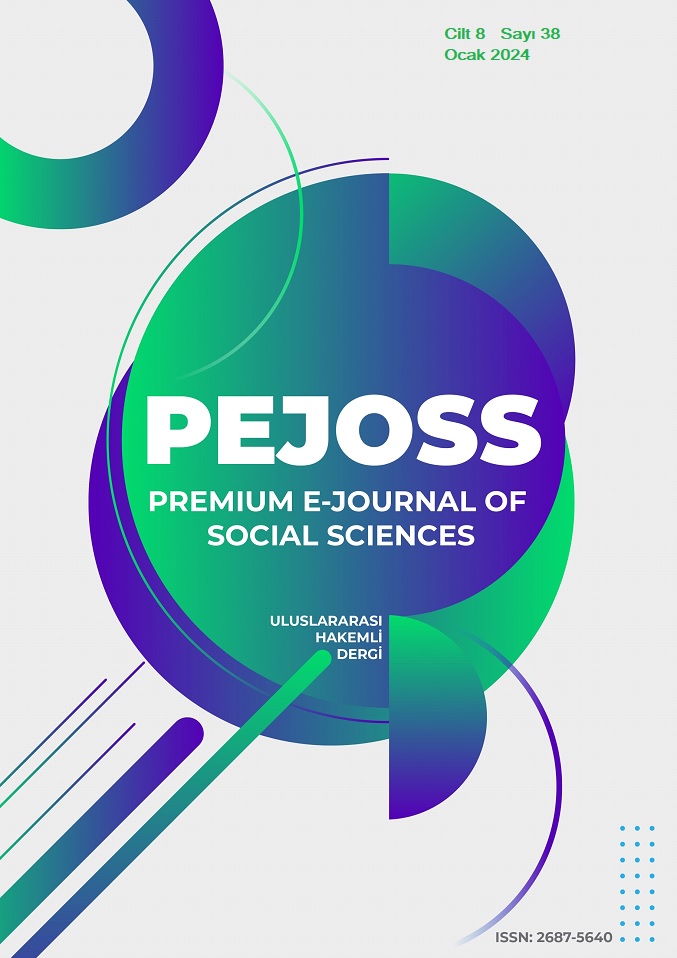As a Rival to Traditional Financial Institutions, an Innovative Financial Application: Fintech
DOI:
https://doi.org/10.5281/zenodo.10616818Keywords:
Finance, Financial Services, FintechAbstract
It is undeniable that the rapid growth of technology is changing financial systems on a global scale and financial services must revise their services to cope with the changes in technological services in the world. It is a fact that one of the concepts that has become popular in the financial world today, especially in recent years, is Fintech. The term “Fintech” is formed by the combination of the English words “finance” and “technology” as a reference to software, hardware, mobile applications and technologies created to automate as well as make classical financial applications functional. Here, the main target is to provide proactive, efficient, fast and reliable financial solutions by using technology. By doing so, individual users can receive personalized services for themselves and have the opportunity to complete their transactions in a very short time. With Fintech, banking and financial services have become much more fluid and accessible.
By using technology, users can now use automation to speed up processes that could previously be performed by a person. As well as these advantages, the most important disadvantages of Fintech include having insufficient capital, lack of adequately equipped personnel, and not having sufficient resources and corporate reputation to provide the trust expected by regulatory legal institutions on the state side. When they first emerged, although Fintech companies were a sub-sector that supported the software and hardware needs of banking and finance companies with the technologies they provided, they have evolved over time and become a formidable rival that the banking and finance sector operating with classical methods must deal with. The present study aimed to provide conceptual data on the concept of Fintech.
Downloads
References
Ali, W., Muthaly, S.and Dada, M. (2018). Adoption of Shariah compliant peer-to-business financing platforms by SMEs: A conceptual strategic framework for fintechs in Bahrain. International Journal of Innovative Technology and Exploring Engineering, 8(2), 407–412.
Ali, M., Raza, S. A., Khamis, B., Puah, C. H., and Amin, H. (2021). How perceived risk, benefit and trust determine user Fintech adoption: a new dimension for Islamic finance. Foresight, 23(4), 403-420. https://doi.org/doi.org/10.1108/FS-09-2020-0095.
Alshater, M. M., and Othman, A. H. A. (2020). Financial Technology Developments and their Effect on Islamic Finance Education. Journal of King Abdulaziz University: Islamic Economics, 33(3), 161–187. https://doi.org/10.4197/Islec.33-3.9
Awotunde, J. B., Chakraborty, C. and Adeniyi, A. E. (2021). Intrusion detection in industrial internet of things network-based on deep learning model with rule-based feature selection. Wireless Communications and Mobile Computing, 2021(2),1–17. https://doi.org/https://doi.org/ 10.1155/2021/7154587
Broom, D. (2016). Innovation in Payments: The Future is Fintech. Bny Mellon. https://www.funds-europe.com/system/tdf/Innovation%20in%20Payments%20-%20The%20Future%20is%20 Fintech.pdf?file=1&type=node&id=313626&force=
Buckley, R. P., Arner, D. W., Zetzsche, D. A. and Selga, E. (2019). The dark side of digital financial transformation: The new risks of fintech and the rise of techrisk. UNSW Law Research Paper, 19-89.
Chen, H. C. and Ritter, J. R. (2020). The seven percent solution. The Journal of Finance, 55(3), 1105- 1131
Cheng, M. and Qu, Y. (2020). Does bank FinTech reduce credit risk? Evidence from China. Pacific-Basin Finance Journal, 63, 101398.
Cuming, D., Johan, S. and Reardon, R. (2023). Global fintech trends and their impact on international business: a review. Multinational Business Review, 31(3), 413-436.
Darmansyah, D., Fianto, B. A., Hendratmi, A. and Aziz, P. F. (2020). Factors determining behavioral intentions to use Islamic financial technology: Three competing models. Journal of Islamic Marketing, 12(4), 794–812. https://doi.org/https://doi.org/10.1108/JIMA-12-2019-0252
Feyen,E., Frost, J., Gambacorta, L., Natarajan, H. and Saal, M. (2021). Fintech and the digital transformation of financial services: implications for market structure and public policy. BIS Papers, Bank for International Settlements, number 117.
Financial Stability Implications from FinTech. Financial Stability Board. https://www.fsb.org/2017/06/financial-stability-implications-from-fintech/
Firmansyah, E. A. and Anwar, M. (2019). Islamic financial technology (FINTECH): its challenges and prospect. Achieving and Sustaining SDGs Conference: Harnessing the Power of Frontier Technology to Achieve the Sustainable Development Goals (ASSDG 2018), 52–58.
Giglio, F. (2022). Fintech: A Literature Review. International Business Research, 15(1), 80-85.
Hasan, R., Hassan, M. K. and Aliyu, S. (2020). Fintech and Islamic finance: Literature review and research agenda. International Journal of Islamic Economics and Finance (IJIEF), 3(1), 75–94.
Irfan, M. and Rusmita, S.A. (2023). explorıng ıslamıc fıntech: a bıblıometrıc approach. JEBIS: Jurnal Ekonomi dan Bisnis Islam, 9(1), 233-249.
Jünger, M. and Mietzner, M. (2020). Banking goes digital: The adoption of FinTech Services by German Households. Finance Research Letters, 34, 101260.
Kabra, A., Apurva. and Jadhav, B. (2023). FINTECH AND BEYOND. The Online Journal of Distance Education and e-Learning, 11(1), 222-228.
Liang, S. (2023). The Future of Finance: Fintech and Digital Transformation. Highlights in Business, Economics and Management, 15, 20-26.
Mollick, E. (2014). The dynamics of crowdfunding: An exploratory study. Journal of Business Venturing, 29, 1-16.
Rabbani, M. R., Khan, S. and Thalassinos, E. I. (2020). FinTech, blockchain and Islamic finance: An extensive literature review. International Journal of Economics and Business Administration, 8(2), 65-86.
Thakor, A.V. (2020). Fintech and banking: What do we know? Journal of Financial Intermediation, 41, 100833.
The Iyer Report. http://www.theiyerreport.com/2017/fintech-where-did-it-start/, Erişim Tarihi: 13.09.2017
Yesugade, A., Chopade, P. and Gupta, K. (2023). ımpetus to the fıntech ın ındıa- a trend analysıs. The Online Journal of Distance Education and e-Learning, 11(2), 1476-1487.
Zhu, Z. (2018). Safety promise, moral hazard and financial supervision: Evidence from peer-to-peer lending. Finance Research Letters, 27, 1-5.
Downloads
Published
How to Cite
Issue
Section
License
Copyright (c) 2024 Premium e-Journal of Social Science (PEJOSS)

This work is licensed under a Creative Commons Attribution 4.0 International License.


